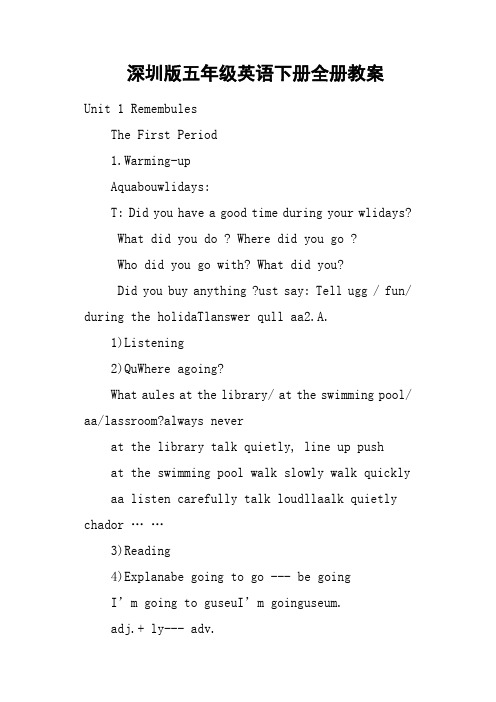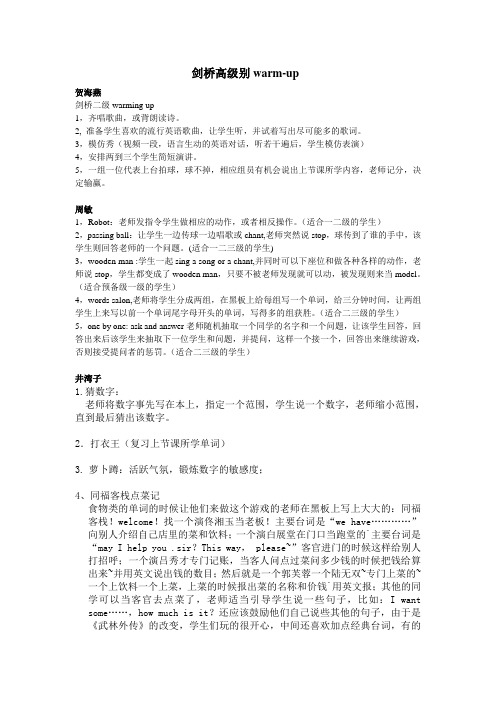warming up 教案
- 格式:doc
- 大小:43.50 KB
- 文档页数:3


人教版高中英语必修二unit5 musicwarming up and reading教案教学基本信息题目学科教材内容设计者 Book2 Unit5 Music-Warming up and reading 年高中英语高一级 Book2 Unit5 Music-Warming up and reading 第一课时个人信息姓名单位谷琴霞江西省金溪县第一中学 1.教材分析 1.本单元的话题是音乐和音乐类型。
内容分三个文段展开,涉及门基乐队,弗雷迪和他的乐队等子话题,而其中的主体内容是围绕着门基乐队的形成和成长历程展开的。
话题设置旨在让学生了解音乐的各种形式,深化对音乐的认识,增添音乐欣赏趣味,提高学生的音乐素养,培养他们热爱音乐和热爱生活的情操。
2.Warming �Cup 由八幅图片和四个问题组成。
图片呈现给学生的是他们熟悉的音乐家、歌唱家、乐队、组合等。
学生能很直观地了解音乐无处不在,让学生感受音乐魅力。
四个问题有助于老师引导学生开口、动脑,谈论他们喜欢的音乐,激发他们积极参与课堂活动的热情,进入本单元话题作铺垫。
3. Pre-reading 提供了三个问题,围绕中心词band 展开活动,要求他们列举出世界著名的乐队,谈论最喜欢哪个以及原因,进而引出阅读中的The Monkees这一主题。
4. Reading 主要介绍The Monkees,文章叙述了歌星、门基乐队充满梦想、如何组成乐队以及他们如何获得成功的过程。
阅读活动的目的在于训练学生阅读技能的基础上,培养学生对择业的思考,意识到机遇和挑战是并存的。
文章的主题是积极向上的,能激励学生通过努力一定能实现对事业的追求。
2.学情分析 1.知识结构:虽然学生Music这一话题有极大的兴趣,已经具备一定的词汇和表达基础,但对门基乐队感到陌生,并且阅读能力有待提高,对阅读技巧的运用还不娴熟,因此,教师应结合学生实际,逐步引导,循序渐进。
2.心理特征:现在的高中学生,对新鲜的事物有极大的接受能力,并且喜欢音乐和各种形象的展示,因此教师可以充分利用多媒体形式调动学生的学习热情,设置有效的阅读任务逐步掌握阅读技巧,体会文章含义。

深圳版五年级英语下册全册教案Unit 1 RemembulesThe First Period1.Warming-upAquabouwlidays:T: Did you have a good time during your wlidays? What did you do ? Where did you go ?Who did you go with? What did you?Did you buy anything ?ust say: Tell ugg / fun/ during the holidaTlanswer qull aa2.A.1)Listening2)QuWhere agoing?What aules at the library/ at the swimming pool/ aa/lassroom?always neverat the library talk quietly, line up pushat the swimming pool walk slowly walk quickly aa listen carefully talk loudllaalk quietly chador … …3)Reading4)Explanabe going to go --- be goingI’m going to guseuI’m goinguseum.adj.+ ly--- adv.quiet, careful, quick, slow, loud, happy, heavd to dxTd Period1.Revases and2.Presentawures of a museum and a hospital, ask Ss : What must we do at the museum? What mustn’t we do at the museum?Repeat wlaHelay: We must look and listen carefully.We mustn’t plaPractice:What aulur house?Ss: You must puubuu mustn’B1 and B21)Listen and answquestions:What must / mustn’t we do at the library?Where agoing then? Why?What’s wrong with Grandma?What agoing to taal?What aules at the adventure land?2)Read and explaB31)Talk about whaach picture2)Laanswxlass:1)We are goinglibrary.(同义句)2)We usually talk quietly at the library.(提问)3)You need to line up.(提问)4)He always writes carefully.(否定)5)We never talk loudly aa.(提问)6)Can I use your pen?u _____.7)May I have an apple?u _____.8)Must we obules? No, you ______.9)他总是谨慎驾驶.10)我上学从不迟到.The Third Period1.Rev2.C. A)Listening2)Questions: What must / mustn’t we do wa fire drill ?must : line up / walk dowairs quickly / be quiet / …mustn’t: push / take…with…3)Reading4)Asking: Why adrillant?3.D 1) Readaga2)Decidare true or fal)answers wAange wordalauDxAAwork in grouuact ouThe Fourth Period1.Rev2)WbolundBb2)Glisten and repea)Alwords and then wundbolDiscussion: What al library rules?Heldiscuss in grouwhich group can ganswF1)Talk wlass about eaure is doing, eg. What is Kevin doing?2)Awrite down each child is doing wronglist belowuld only use must or mustn’t3)Pugrouand adiscuules in a museum or a Children’s Pala)Gllblal)Go through the answers wlaG. Listen and chaDxThe Fifth Period1.RevGak out the rules at a library, in a museum, at a Children’s Palace… as quickly aan.2.Talabout what rulllow ouPgns and ask whaaxplalanguagat ag , be called, at traffic lig—walk auntil, not… until…Dxercises:1.用适当的形容词或副词填空(可有一个以上答案)1)Be ______! The bug.2) He always lachers __ in cla)She was very anguted ____”Get out!”4) There was a __ raday. It rained ___.5) The tra_______. Please drive _____.6)You mustn’t talk ______ at the libra)We must walk _______dor.1.我们必须有礼貌.2.他能很快的回答问题.他一定是个聪明的学生.3.在冒险乐园你们必须小心.4.我们必须在走廊里安静的排队.5.This dog ____ ____ Boby. (被叫做)6.当交通灯是绿色时,我们必须迅速过马路.W__ __is green ,we___ ___ ___the road ____深圳街道上有太多的来往车辆.There ___ ___ ___ ___ ___Z 她很有礼貌,她总是礼貌的交谈.___ . She ___ ___ ___.The Sixth Period1.Go through the exWB2.Do some listening exDo some writing exDal praHave a dicta后记:本课学习的一些副词较难。

剑桥高级别warm-up贺海燕剑桥二级warming up1,齐唱歌曲,或背朗读诗。
2, 准备学生喜欢的流行英语歌曲,让学生听,并试着写出尽可能多的歌词。
3,模仿秀(视频一段,语言生动的英语对话,听若干遍后,学生模仿表演)4,安排两到三个学生简短演讲。
5,一组一位代表上台拍球,球不掉,相应组员有机会说出上节课所学内容,老师记分,决定输赢。
周敏1,Robot:老师发指令学生做相应的动作,或者相反操作。
(适合一二级的学生)2,passing ball:让学生一边传球一边唱歌或chant,老师突然说stop,球传到了谁的手中,该学生则回答老师的一个问题。
(适合一二三级的学生)3,wooden man :学生一起sing a song or a chant,并同时可以下座位和做各种各样的动作,老师说stop,学生都变成了wooden man,只要不被老师发现就可以动,被发现则来当model。
(适合预备级一级的学生)4,words salon,老师将学生分成两组,在黑板上给每组写一个单词,给三分钟时间,让两组学生上来写以前一个单词尾字母开头的单词,写得多的组获胜。
(适合二三级的学生)5,one by one: ask and answer老师随机抽取一个同学的名字和一个问题,让该学生回答,回答出来后该学生来抽取下一位学生和问题,并提问,这样一个接一个,回答出来继续游戏,否则接受提问者的惩罚。
(适合二三级的学生)井湾子1.猜数字:老师将数字事先写在本上,指定一个范围,学生说一个数字,老师缩小范围,直到最后猜出该数字。
2.打衣王(复习上节课所学单词)3.萝卜蹲:活跃气氛,锻炼数字的敏感度;4、同福客栈点菜记食物类的单词的时候让他们来做这个游戏的老师在黑板上写上大大的:同福客栈!welcome!找一个演佟湘玉当老板!主要台词是“we have…………”向别人介绍自己店里的菜和饮料;一个演白展堂在门口当跑堂的`主要台词是“may I help you .sir?This way,please~”客官进门的时候这样给别人打招呼;一个演吕秀才专门记账,当客人问点过菜问多少钱的时候把钱给算出来~并用英文说出钱的数目;然后就是一个郭芙蓉一个陆无双~专门上菜的~一个上饮料一个上菜,上菜的时候报出菜的名称和价钱`用英文报;其他的同学可以当客官去点菜了,老师适当引导学生说一些句子,比如:I want some……,how much is it?还应该鼓励他们自己说些其他的句子,由于是《武林外传》的改变,学生们玩的很开心,中间还喜欢加点经典台词,有的同学看菜太贵了还说“饿滴神啊!!”5、有黏性的胳膊目的:熟悉和区分I like...以及He\She likes...及其相应的否定形式。

第 1 次课程教案●Period 11. Warming-upTask: Complete the following table seating arrangement.Step1: What are the principles of seating arrangement?1.Seat people who have common interests together.2.Pair male and female guests.3.Seat guests of honor in order. The most important person should be seated at the right hand ofthe host.Step2: Ask Ss to match the guest names to seats A-E.Step3: Ask some Ss to give their answers and explain them to the class.Step4: Comment briefly on their work and give the suggested answers.●Period 22. New words and phrases in Reading AStep1: Read the new words and phrases in Reading AStep2: Analysis of the new words and phrases in Reading A1) entertain v. 招待;给…娱乐e.g. entertain friends at dinner 招待朋友吃饭A teacher should entertain as well as teach. 教师不仅要教书,也要能引起学生兴趣。
相关派生词: entertaining a. 使人愉快的,有趣的an entertaining story 一个有趣的故事entertainment n. 招待,娱乐A cinema is a place of entertainment. 电影院是公众娱乐场所。

不可忽视的“Warming-up”热身活动,即每节课教学活动开始时的第一个环节,Warming-up。
热身导入是传授新课的“序幕”,热身运动让学生们能从中集中精神,把注意力集中到课堂上。
同时,热身活动的内容也将为本节课的主要学习的内容作一铺垫。
它为培养学生兴趣,抓住学生心弦,优化学生心境,及新知识的探求、运用作了准备。
引人入胜的热身导入就如戏剧演出的“镇场”,它是教师与学生建立的第一座情感桥梁,既能吸引学生的注意力,又能激发起学生内在的求知欲,为新知识的学习做引子、做铺垫,为整堂课的和谐自然发展定下基调。
一.英语课前热身运动的重要性1.课前热身运动有助于激发学生的兴趣语言学习本身较为单调枯燥,如果一味坚持以教师的讲,领读,学生的听、跟读这种鹦鹉学舌式的教学形式,势必会让好动的孩子们学习兴趣荡然无存。
有人说兴趣是最好的老师,是学生学习动力取之不尽的源泉。
如何激发学生课堂中的学习兴趣?一个重要环节便是作好课前热身运动。
现在的小学英语教师大都能够提前踏进课堂,为上课设计板书,或抓紧时间和学生练口语,或唱几首英文歌曲来激发学生的学习兴趣。
学生听懂了并能对答如流,就会由衷地产生一股兴奋感和成功感。
这是最佳的课前热身,比我们常用的“Stand up, please.”这类千篇一律,陈旧呆板的开场白更能激发起学生的内在热情,投入课堂。
当上课铃响起时,教师走上讲台说:“Is it time for class?”“Are you ready?”等等课前这样的过渡,既吸引了学生的注意力,又找到了师生进入共同学习的良好契机。
英语作为一门技能课,需要时间去大量地听、说、读、写,但一星期三节课远远满足不了英语学习大容量的训练。
如何在每节课40分钟的时间内,让学生学到更多、学得更快、更准确,而且要学得有趣儿、有味儿,便成了小学英语教学的难点。
2.课前热身运动有助于缓解压力,放松心情对学生而言,学习新知识是很紧张的,需要注意力高度集中。
20100929成人部第二次教研Warm-up游戏汇总1. 口香糖活动程序:所有人围成一个圆圈,先由一人站在团体中说:“口香糖。
”,旁人问:“粘什么?”,如果那人说:“粘耳朵。
”,那么所有学员就必须找人来两两配对将耳朵贴在一起。
没有找到人配对的学员就要站到中间继续游戏。
2. 晋级规则:让所有人蹲下,扮演鸡蛋。
找人猜拳(或其它可以决定胜负的游戏),胜者进化为小鸡,可以站起来。
然后小鸡和小鸡猜拳,胜者进化为凤凰,输者退化为鸡蛋。
看看谁是最后一个变凤凰的。
3. 两真一假请每个人写下三件关于自己的事(比如生日是哪天,多少孩子,我中过彩票),其中两件真的,一件是假的,并做好真假标识,以供大家辨认。
读出来让大家猜哪句真哪句假。
4. 滚雪球:适用于第一节课游戏规则:1.全班同学坐成一个圈,然后由第一个同学做自我介绍:我叫$$$,我来自@@,我的职业是@@,我喜欢@@@。
”2.第二个同学做自我介绍的时候就必须说:我是坐在名字叫$$$,来自@@,职业是@@,喜欢@@@的隔壁的@@@,我来自@@,我的职业是@@,我喜欢@@@。
”3.依次类推,第三个同学就必须说出第一个同学和第二个同学的信息。
这个游戏适合在第一次见面的场合使用,可以让学生相互认识,同时记住班上同学的其他信息。
5. 游戏之"解结":游戏规则:1.同学们围成一个圈,老师们随意挑选两个人,手拉手2.当所有人的手拉在一起时,纠结在一起的"人链"开始一个个穿越,解开乱成一团的结。
本游戏结束后,可以告诉我们的学生,只要有耐心,慢慢来,没有解不开的结。
学习英语也是同样的道理,没有解不开的结,要有耐心和恒心6. Simon says游戏规则:当老师说:simon says @@@,学生要跟着老师的口令做动作,如果老师只说@@@,学生则要保持原来的姿势不动。
7. 见面打招呼游戏规则:1.全班同学围成一个圈2.第一个同学向第二个同学打招呼并加上动作,如:Hello ,my name is @@@.然后给第二个同学一个拥抱;第二个同学跟第三个同学打招呼的时候就要说:nice to meet you.并和对方握手;3.依次类推第三,第四个同学打招呼,但是不能重复使用别人用过的动作和英语的用语(注:英语用语不限于打招呼的用语),否则就算输了8. 五子棋:分组游戏游戏规则:老师可根据学生回答问题的情况,让学生在在棋盘内放棋子,最后看谁城的多为胜者。
Warmup幼儿园教案教学背景本教案适用于幼儿园中班或大班的英语教学。
在进行正式的课堂活动前,这个Warmup教案将介绍一个有趣的活动,使孩子们在轻松的氛围中温习前几堂课所学的内容。
这个Warmup教案的主要目的是培养学生对英语语音和单词的接触感和快速反应能力。
使用这个教案,学生将更容易理解和接受下一堂课的语言资料,并激发他们学习英语的兴趣。
教学目标•帮助学生回顾和巩固前面几堂课所学的主题、语音和单词;•培养学生在竞赛环境下快速反应英语语音和单词的能力;•培养学生的英语自信。
教学准备•打印胜者和失败者卡片;•记录孩子的得分和时间的表格。
•准备表扬和小奖励。
教学步骤第一步:介绍胜者和失败者卡片老师向学生们介绍卡片。
老师将这些卡片放在桌子上,然后向学生解释使用这些卡片的方法。
老师:孩子们,我们今天玩一个有趣的游戏,叫做胜者和失败者。
这个游戏的目的是帮助你们温习之前学过的英文单词和语音,让你们更好地掌握这些知识。
我们将使用这张胜者卡片和这张失败者卡片。
当我们玩这个游戏时,你们将要听到一个单词或一句话,你们需要尽快回答是否正确。
如果你回答正确,你将得到这张胜者卡片。
如果你回答错误,你将得到这张失败者卡片。
最后获得胜者卡片数量最多的同学将获得表扬和奖励。
第二步:开始游戏老师给出一个语音或单词,学生们听取之后,迅速回答这个单词或语音是否正确。
当学生回答正确时,老师将给他们发放胜者卡片; 如果学生答错了,老师将给他们放放失败者卡片。
游戏持续5分钟钟。
然后老师将结束游戏,并统计每个学生的得分。
第三步:表扬和奖励老师将表扬得分最高的学生,并奖励他们。
老师还可以给所有参与游戏的学生派发一些小礼品,以便他们都能感觉到被认可和赞赏。
总结这个Warmup幼儿园教案是通过有趣的游戏来帮助幼儿园学生回顾和温习之前学过的英文知识的一个好方式。
通过这个活动,孩子们将更好地理解和掌握下堂课程的语言资料。
注意,重点不在于分数和获胜,而在于培养学生的英语兴趣和自信。
Unit 2 The Olympic Games
( BOOK II )
The teaching plan for warming up and pre-reading I. Teaching background information
Student: 36 students in Class 9 Grade 1
Teacher: Lu Jiao
Time: 40 min.
Date: Nov. 22nd, 2011
II. Aims and demands
1. To arouse student s’ interest in learning about the information of the
Olympics
2. To introduce the difference between the ancient Olympic Games and
the modern Olympic games
3. To t rain the students’ abilit ies to search the information in many
ways, for example, in the book, on the newspaper, on the internet
and so on
4. To t rain the students’ abilities to study independently and cooperate
with others
5. To train the students’ abilities of speaking
III. Teaching important points
1. To arouse stud ents’ interest in learning about the Olympics
2. To train the students’ studying abilities—searching information,
studying independently and cooperate with others
IV. Teaching methods
Task-based Language Teaching
V. Teaching aids
CAI, PPT, music
VI. Teaching procedures
Step 1 Pre-task
Enjoy the song named Welcome to Beijing with some sports
pictures which welcome people all over the world to Beijing to
celebrate the 2008 Olympic Games. And then let the students
guess the name of the song to lead in the topic: the Olympic
Games.
Step 2 Task cycle
Task 1. Before this class, the teacher guides the students to form six groups and every group has six members. And then
the students should search some information about the
Olympic Games together on the internet, on the
newspaper or in the book and so on. After that, every
group makes a PPT and chooses a reporter to share their
searching fruits with the classmates. Here are the six
topics:
1. The History of the Olympic Games
2. The Olympic Five Rings
3. The Spirits of the Olympic Games
4. The Kinds of the Olympic Games
5. The Beijing Olympic Games
6. The London Olympic Games
Task 2. Teacher invites four groups to give their reports in turns and then the teacher gives some opinions about their
searching fruits one by one.
Task 3. The students do the questions below to check whether they have mastered the information about the Olympic
Games
1. When and where did the ancient Olympic Games start?
Answers: 776BC, Olympia
2. How many countries competed in the ancient Olympic
Games?
Answer: Greece
3. Who could not take part in the ancient Olympic
Games?
Answer: Women and slaves
4. When and where did the modern Olympic Games start?
Answers: 1896, Athens
5. Who was China’s first gold medal winner a nd for what
event?
Answers: Xu Haifeng, shooting
6. What are the three words that show the spirit of the
Olympic Games?
Answer: Swifter, Higher, Stronger
7. What do the five rings on the Olympic flag stand for?
Answer: Five Continents
8. What are the official mascots for the Beijing
Olympic?
Answer: One World One Dream
Task 4. Memorize: What we have learnt today.
The teacher guides the students to memorize what we
have learnt in this class.
Step 3 After task---homework
1. Please search more information on the internet, on the
newspaper or in the book and so on.
2. Prepare the Reading text for next class.
Step 4 Enjoying time
Enjoy the song named Hand in Hand and some great athlete’s
pictures to learn from the athletes about their courage.。